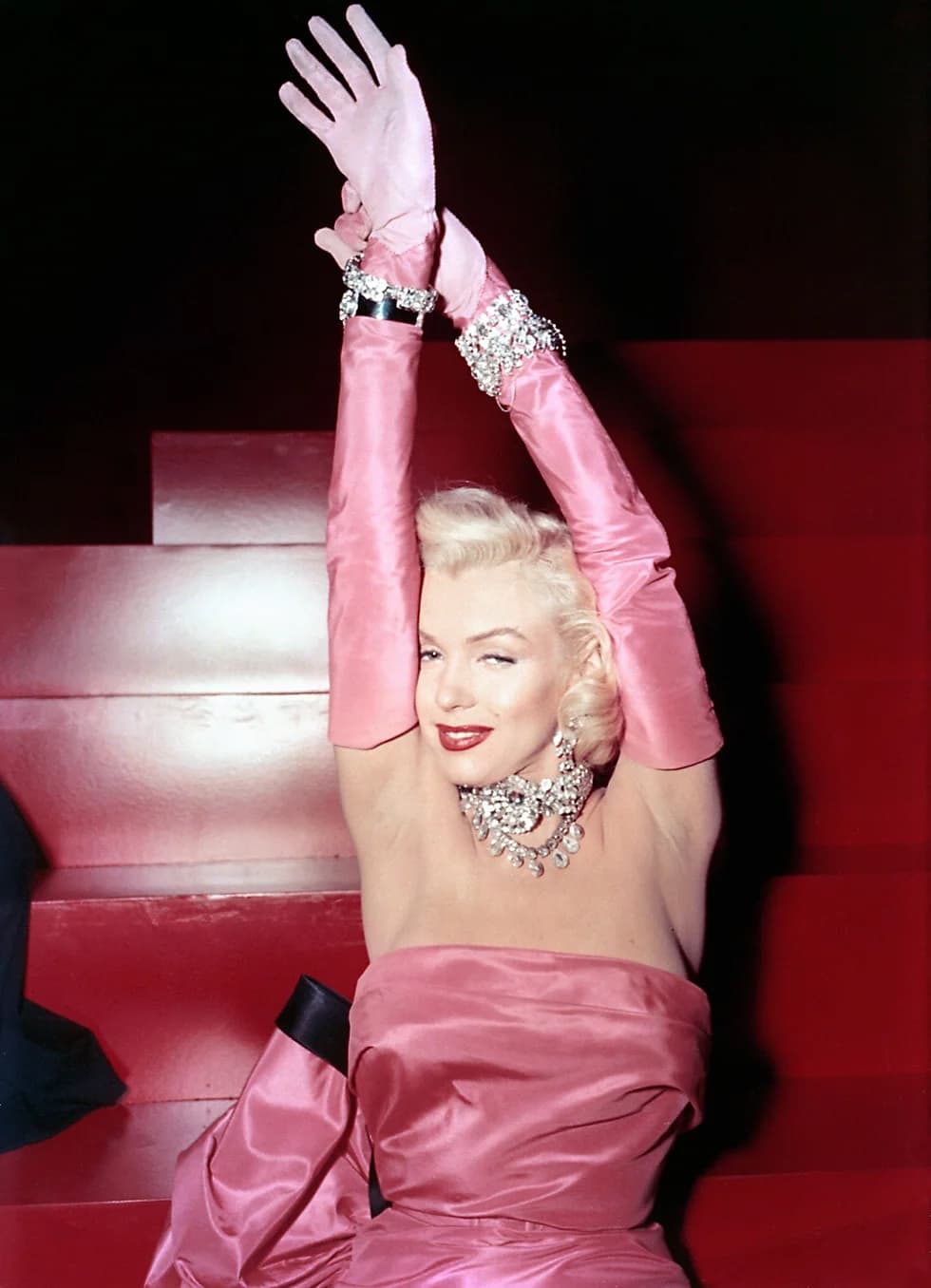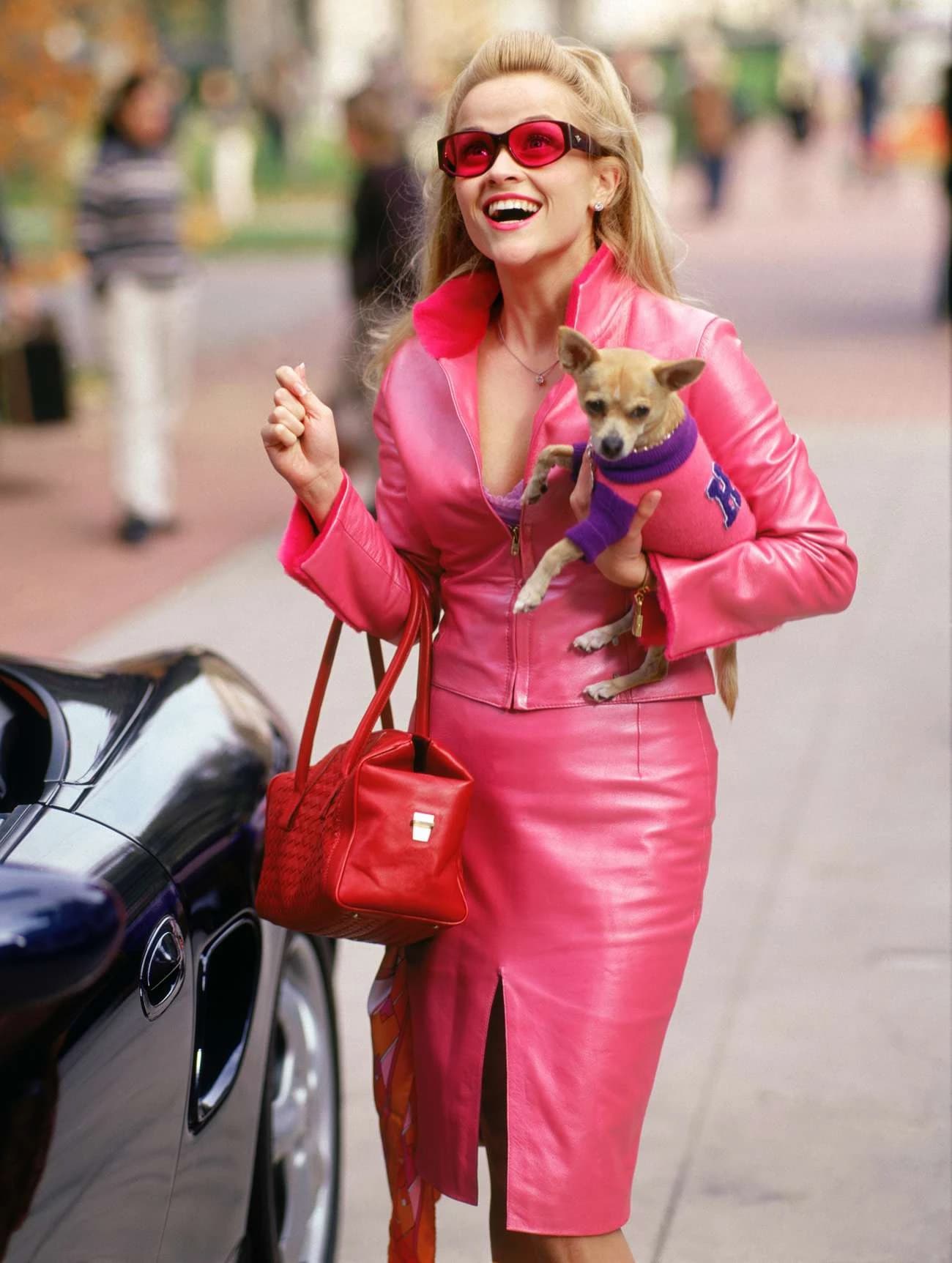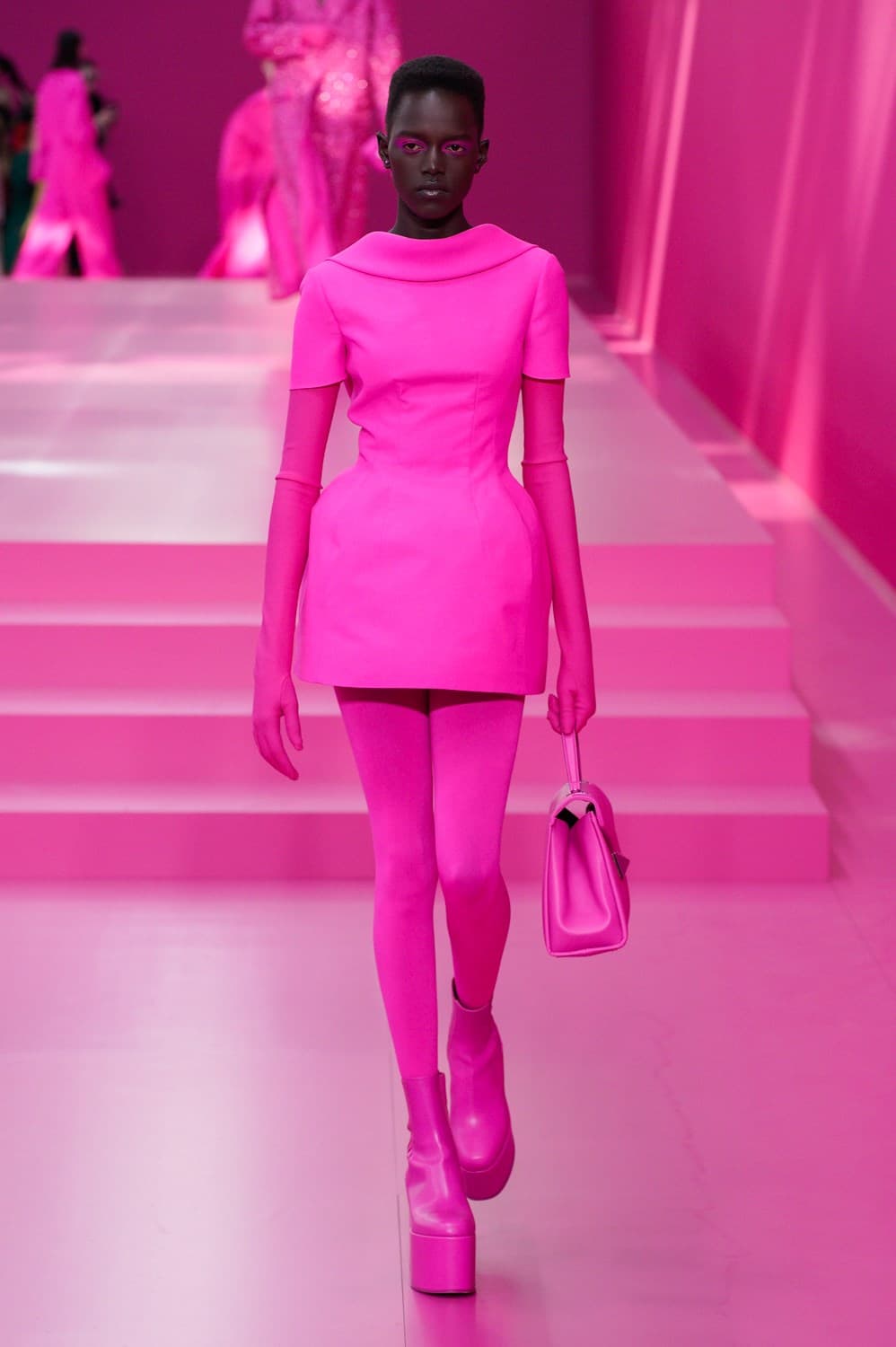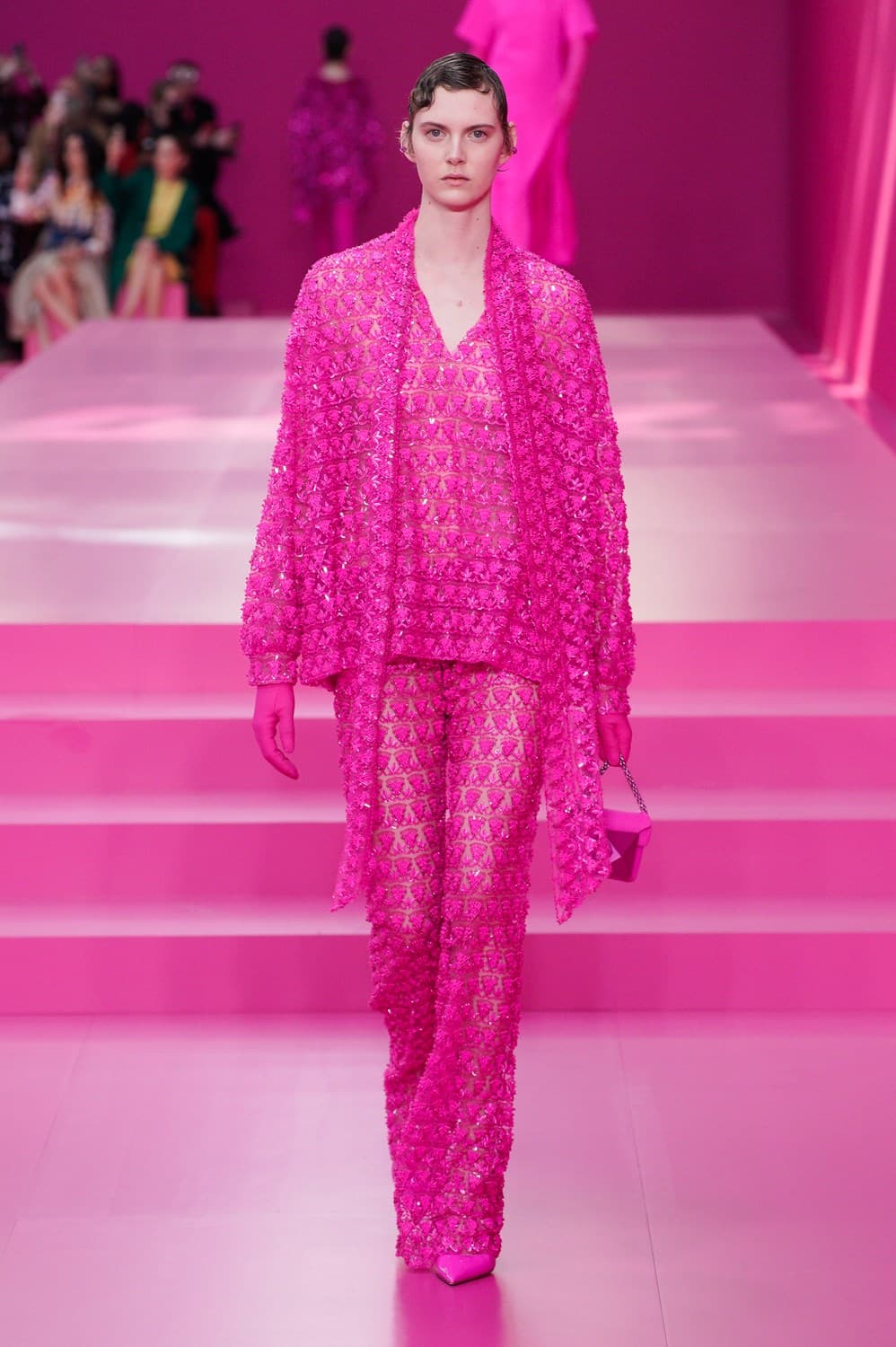“Pretty in Pink: The Resurgence of Pink and its Transcending Power
By LIzzy Bowring
When the world needs moments of optimism and comfort, a whiff of Pink washes over the world; the color once associated with femininity and gentility has undergone a bold rebranding. Its phenomenon is sweeping the fashion, design, and film world and reshaping our perception of this often-underestimated color. Today, it represents strength, empowerment, and vibrancy. Is it here for the foreseeable future? The Impression explores the longevity of this romantic and whimsical hue through cultural evolution, significance, and resurgence.
Key Takeaways
The color Pink has translated as a symbol of resistance, becoming powerful in feminist activism and popular culture. Today, it is an important color for designers, representing various emotions, from gentleness and compassion to strength and subversion, forthright and fun. Valentino’s A/W 22 collection, for instance, chose to use a combination of pink and black, highlighting the individual characteristics and expressions of the models. The choice of pink today is never random; it encompasses various connotations ranging from gentleness and femininity to strength and empowerment.
In essence, the color pink is continuously evolving, reflecting societal changes and trends. From gender to class, the color’s associations have been constantly challenged, flipped, and subverted, proving its enduring cultural influence. The history of the color pink is as diverse as it is vibrant. And as is evident throughout history, designers, artists, and brands have played with the emotions the color evokes, shaping ever-evolving meanings — while the definition of Pink is continuously in flux, there’s one constant: its cultural staying power.
Index
- A Future Painted Pink.
- The Pink Evolution.
- Hidden meaning: A modern reinterpretation with a new purpose.
A Future Painted Pink.
Pink has become, in many ways, the most controversial color in fashion, and fashion is always interested in controversy.
– Valerie Steele
It’s intriguing to see how color trends, including the resurgence of pink, are influenced by societal changes. In an era that the World Economic Forum’s Global Risks Report 2023 describes as a ‘poly-crisis,’ shades of Pink, familiar and calming, become more potent. With unprecedented global changes and increasing uncertainties, color has become a medium to reassure and uplift. Nostalgic hues, calming mid-tones, and soft neutrals are vital in soothing the mind and creating a comforting ambiance procuring feelings of solace, rest, and a sense of luxurious tranquility.
While the color’s sense of nostalgia provides comfort and stability amidst cascading global crises, it highlights the compounding effects of various risks. It emphasizes that the overall impact is more than just the sum of its parts. Pink provides a soothing, familiar anchor in these turbulent times, further fueling its resurgence.
Yet Pink also transcends the emotional connection and is a crucial component for the future. The return of a palette of vibrant, glowing hues brings an element of fantasy to our everyday lives, bridging the harmony of nature and the boundless creativity offered by the future of AI. Shades of Pink are part of the Bioluminescent color spectrum, reminding us of the natural world’s beauty and mystery and where the line between the digital and physical worlds blurs even more. This transformation is reflected in what might be called “otherworldly pastels,” living in creative harmony with darker luminescent hues, shifting pastels from their typical ‘delicate’ narratives to hybrids that emit a futuristic vibe, ensuring that these color tones, including Pink, over time, are here to stay.
The Pink Evolution.
Pink has evolved, carrying with it diverse connotations.
As early as the 17th century, in Eastern cultures, such as Japan, it was traditionally seen as a masculine color, symbolizing the death of Samurai warriors who followed the Bushido code. The annual blooming of pink cherry blossoms, or Sakura, is also a significant cultural event in Japan, symbolizing the ephemeral nature of life due to their short blooming times.

In Korea, pink represents trust. Pink has become increasingly popular in South Korean pop culture in recent years, especially with the global rise of K-Pop and Korean dramas; this has led to the widespread use of the color in just about every facet of merchandise and marketing, extending the connotation of Pink to youthfulness, escapism, and positivity. In India, Pink is generally associated with celebrations and festive occasions, especially in the northern part of the country. Jaipur is famously known as the “Pink City” due to the color of its stone architecture. It’s also worth noting that pink saris are a common sight at Indian weddings, symbolizing joy and femininity.
According to historian Valerie Steele, one of the authors of “Pink: The History of a Punk, Pretty, Powerful Color,” the birth of pink in modern fashion began in the 18th century, gaining popularity among the nobility, primarily due to developments in dye-making and the French court’s preference for fashionable attire. Madame de Pompadour, King Louis XV’s mistress, played a crucial role in popularizing the color, often portrayed wearing pink in paintings. Consequently, the color became associated with French high fashion, spawning a specific eroticized image of femininity. Pink’s association with wealth and prestige ebbed as the color became more accessible with the development of cheaper dyes. While initially worn by both genders, the 1920s saw a shift in the United States, with department stores starting to market blue for boys and pink for girls. This arbitrary decision stuck and influenced color-gender stereotypes for generations.




By the mid-20th century, Pink was heavily associated with traditional femininity, evident in the 1950s when pink was symbolic of the ideal woman in both Hollywood and households. Marilyn Monroe’s iconic pink dress in “Gentlemen Prefer Blondes” reinforced her image as a desirable sex symbol. At the same time, the 1957 musical film “Funny Face,” with Audrey Hepburn and Fred Astaire in the lead roles, set in New York City’s fashion world, was noted for its attention to fashion and style. The film was nominated for several Academy Awards, including Best Costume Design, pertinent to our discussion about Pink. One of the film’s most iconic scenes takes place in the darkroom; the room is bathed in red and pink lighting, creating a striking visual effect that contrasts with the rest of the film’s primarily neutral color palette.
Another notable moment is the gown worn by Hepburn. Although the gown isn’t pink, the scene’s backdrop is soft, romantic Pink, enhancing the character’s elegant transformation. “Funny Face” uses the color pink to symbolize romantic and feminine moments, in line with the traditional connotations of the color. However, the color is used sparingly, making its appearance even more impactful and emphasizing the focus less on bold colors and more on sophistication and elegance.
The following examples show how the color pink can significantly impact visual storytelling and characterization in popular media, influencing not only aesthetic choices but also viewers’ perceptions of characters and situations.
In the film “Legally Blonde,” Elle Woods’ vibrant pink attire symbolizes her refusal to conform to conventional expectations, turning the stereotype of pink as a “girly” color into a symbol of empowerment and defiance. Similarly, in “The Marvelous Mrs. Maisel,” the shades of pink used in costuming reflect the character’s evolution throughout the series, demonstrating the color’s flexibility and complexity.
The reference to Greta Gerwig’s film and the use of “Barbie Pink” underscores how color can create a distinctive visual impact and generate cultural discussions.


Hidden meaning:
A modern reinterpretation with a new purpose.
Beyond the 1950s, Pink moved away from its associations with conformity and took on a new purpose: resistance. Paul Simonon, the bassist for the English punk band The Clash, famously said that “pink is the only true rock and roll colour”. We see how punk musicians reappropriate Pink’s sweet and girlish connotations to create subversive performances. For her 1999 performance at Glastonbury, Courtney Love – notorious for her raw and raucous vocals – unexpectedly swapped her rebellious grunge girl look for a pink costume of ballet slippers and fairy wings.
Pink is also the colour of feminist activism. The 2017 women’s march saw protesters taking to the streets in pink “pussy hats.” They were responding to a recording of then-president Donald Trump, in which he boasted about grabbing women “by the pussy”. This explicit connection between pink, female genitalia, and activism is a feminist statement emphasizing women’s lack of autonomy over their bodies in a patriarchal society. The connotations of Pink are not fixed but malleable.


Whether worn by film stars, musicians, or celebrities, the colour takes on new meanings through irony and reclamation. The 2001 film Legally Blonde subverts the gendered “dumb blonde” stereotypes associated with wearing pink by following the successes of a sorority girl who goes to law school.
When Madonna donned her pink Material Girl look, she positioned herself as the new Marilyn Monroe: a blonde bombshell for the era of Second Wave Feminism. She reworked Monroe’s tragic stardom into a narrative about female empowerment and survival. On TikTok, the #Bimbo trend involves feminine-presenting content creators finding inspiration in the once derogatory “bimbo” label. Their videos reclaim the label as a playful aesthetic and a new feminist lifestyle. Despite its longstanding associations with feminine frivolity and excess, pink consistently proves to be a transgressive colour. It moves with the times and does not stop parodying its past. And if Paris Hilton’s surprise runway appearance in sparkling pink Versace bridal wear tells us anything, Pink should never be underestimated. It still has the power to shock, fascinate and make a statement.


Indeed, the journey of Pink through the ages has reflected shifts in societal norms and attitudes. In 2016, Pantone selected “Rose Quartz,” a muted dusty pink, as one of its Colors of the Year, symbolizing compassion and a sense of composure. The Vice President of the Pantone Color Institute, Laurie Pressman, explained that one of the reasons behind this choice was the increasing blur of gender norms, reflecting the progressive movement towards gender fluidity and equality. Both fashion and interior designers quickly adopted this version of Pink, known as “millennial pink.”
Over the years, Pink has also become a color of empowerment. The iconic “Barbie Pink,” associated with the brand, is viewed as a symbol of female empowerment. Barbie, often seen wearing pink, was one of the first dolls that represented women in roles outside the traditional housewife, significantly influencing generations of young girls.
In a marketing context, color is vital as a nonverbal communication tool. According to David Loranger, a fashion merchandising and marketing professor, colors can instantly convey various emotions. Marketing strategies that tap into emotions are often the most successful, and color is a powerful semiotic vehicle to achieve this.
In today’s world, pink continues to evolve. It can represent gentleness, calmness, compassion, strength, empowerment, and subversion. Its color consistently sparks interest and controversy, keeping it at the center of fashion and design discussions.
Valentino’s A/W 22 collection, masterminded by Creative Director Pierpaolo Piccioli, was a study in restrained color usage and detail attention. The striking combination of pink and black was an intentional decision designed to invoke reflection and highlight the individual characteristics and expressions of the models.





Using just two colors for an entire collection is an audacious choice, forcing the viewer to pay more attention to the details of the garments and the models themselves. The choice of Pink was not random either. As discussed earlier, Pink has various connotations ranging from gentleness, femininity, and romance to strength and empowerment, and, coupled with black, a color often associated with power, elegance, and sophistication, presents a visually striking and meaningful palette. Italian artist Lucio Fontana inspired Piccioli’s collection. Fontana’s works are often seen as destructive at first glance. Still, they can also be interpreted as creating new opportunities and dimensions, just as Valentino’s collection’s black and pink combination pushed the boundaries of traditional color usage in fashion.



By creating a monochromatic backdrop of the same shade of Pink as used in the collection, Piccioli further intensified the focus on the details of each garment and the personalities of each model. He aimed to offer viewers a more profound understanding of his work beyond its immediate visual impact, encouraging them to delve deeper into the intricacies of design and the models’ individuality. It was a move towards seeing fashion as an expression of personality and individualism rather than simply a collection of aesthetically pleasing looks.
And there it is! Profound Pink.
In conclusion, pink has emerged as a versatile hue in both activism and popular culture, symbolizing a spectrum of emotions from compassion to empowerment. Its dynamic use underlines its evolving societal significance. Though the connotations of pink may shift over time, its enduring cultural impact remains undeniable.
